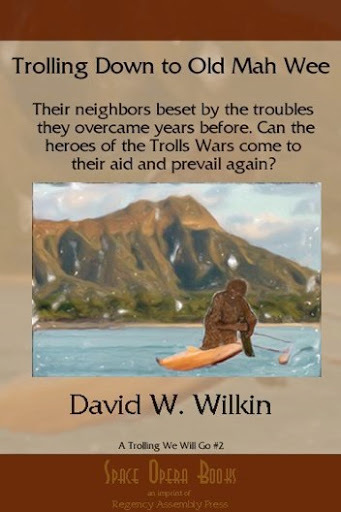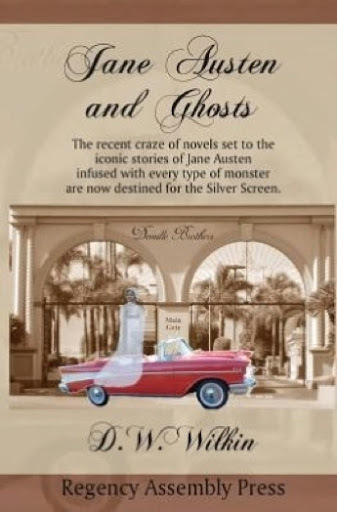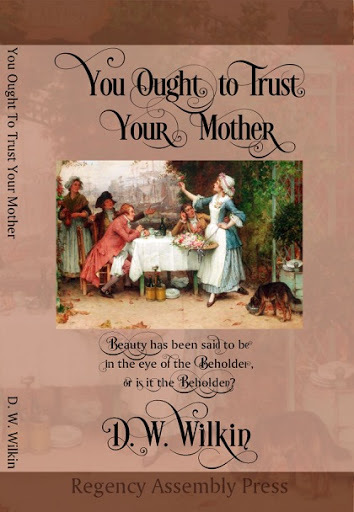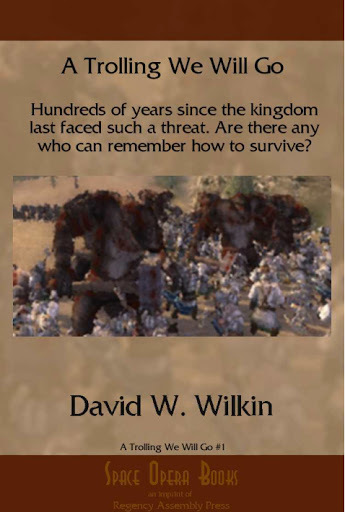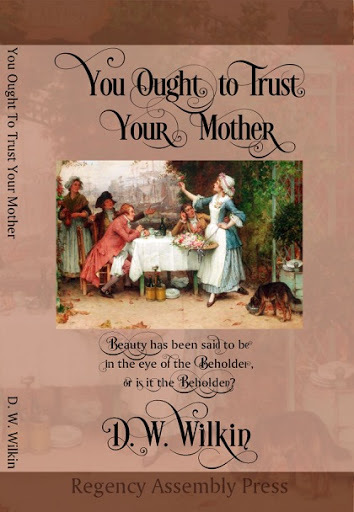D.W. Wilkin's Blog, page 53
May 16, 2016
Regency Personalities Series-Lady Charlotte Finch
Regency Personalities Series
In my attempts to provide us with the details of the Regency, today I continue with one of the many period notables.
Lady Charlotte Finch
14 February 1725 – 11 July 1813
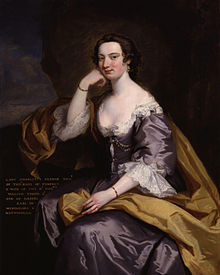
Charlotte Finch
Lady Charlotte Finch was the second eldest daughter of Thomas Fermor, 1st Earl of Pomfret and his wife Henrietta Louisa Jeffreys. The growing family would come to include ten children: four sons and six daughters. Lord and Lady Pomfret held various court appointments during their lifetimes; the earl served as Master of the Horse to Queen Caroline while his wife was a Lady of the Bedchamber.
Charlotte and her family were well travelled and sojourned to cultural and historical landmarks on the continent. While details on Fermor and her sisters’ education are minimal, mention of them in contemporary diaries implies they were well-educated. She and Lady Pomfret were well-read and interested in theology; Charlotte’s friends included the educated Elizabeth Carter. Charlotte was fluent enough in Italian for Horace Walpole to remark in 1740, she “speaks the purest Tuscan, like any Florentine” and “the Florentines look on her as the brightest foreigner that has honoured their [Accademia].” According to Walpole, Lord Granville, who had been briefly married to Charlotte’s sister Sophia, was “extremely fond” of Charlotte; after Sophia’s death in 1745, Granville gave his deceased wife’s jewels to Charlotte, “to the great discontent of his own daughters”.
On 9 August 1746, Charlotte married the Hon. William Finch (1691–1766), heir to his brother Daniel Finch, 8th Earl of Winchilsea. Shortly after the wedding, Walpole reported that Charlotte had five thousand pounds from her father, a sum that would increase when “Mr Finch settles fifteen thousand pounds more upon her”. William Finch had previously been married to Lady Anne Douglas but had no issue. He was a diplomat who served as envoy to Sweden and the Netherlands in the 1720s before becoming an MP for Cockermouth and Bewdley. Another of his roles, held from 1742, was to serve as vice-chamberlain of the royal household. He and Lady Charlotte had one son and four daughters together. One of their daughters died in 1765. Their only son, George, inherited the earldoms of Nottingham and Winchilsea from his paternal uncle in 1769.
Lady Charlotte Finch’s career as royal governess began in August 1762, when she was appointed a day after the birth of George, Prince of Wales, the eldest son and heir of King George III and Queen Charlotte. Walpole called the decision “a choice so universally approved that I do not think she will be abused even in the North Briton“. Lady Charlotte held the role of royal governess for over 30 years, and oversaw 14 of the king and queen’s 15 children.
She presided over the royal nursery, overseeing the staff members designated for each child; the staff included sub-governesses, teachers, personal attendants, and assistant governesses. She oversaw the princes until they became old enough to live in their own households, while the six princesses remained under her supervision until they turned 21.
In the mid-1760s, shortly after her appointment, troubling developments began occurring in Lady Charlotte’s home. One of her daughters died in 1765. Furthermore, William Finch, who was 34 years older than his wife, had by 1765 become senile and mentally unstable. Rumours circulated that he threw her down a staircase. Fearing for her safety, she obtained a formal separation from her husband, taking their children to live with her in an apartment at St James’s Palace and a house in Kew. He died in late 1766. Despite these stresses on her personal life, Finch continued to fulfil her position with zeal. However, when another of her daughters became ill in early 1767, Finch took leave of her job and brought the young girl to various locales in the unsuccessful hope she would survive. Finch left the sub-governess Mrs Cotesworth in charge and returned grieving in November 1767, in time to care for the fifth addition to the nursery, Prince Edward.
Lady Charlotte has been variously described by biographers as warm, competent, and kindly. As was typical for the period, the children were infrequently seen by the king and queen; Finch was the unvarying adult figure in their lives. While the royal princes endured disciplined lessons in an austere educational environment, Finch was loved by her female charges. They affectionately referred to her as “Lady Cha”, and upon returning from a trip to the continent in 1771, Queen Charlotte wrote her, “They can never be in better hands than yours”. Shefrin says that Finch “supervised a progressive nursery focused on child-centred learning” and shared a passion for education with Queen Charlotte, as is evident in their correspondence and the writings of contemporaries; the idea of noble mothers encouraging education for their children – a concept advocated by educators and scholars – was becoming popular, and Finch’s approach at court helped spread these new educational theories. Among the methods she employed was the use of “dissected maps”, some of the earliest jigsaw puzzles, to teach geography.
The historian Flora Fraser writes that “in many ways, the education… ordered for the princesses would be as rigorous as” that which the king ordered for the princes. Queen Charlotte felt that a woman equipped with an education was as able as a man. An accomplished woman herself, Finch, alongside Mrs Cotesworth, organised lessons in the arts and sciences which were taught to both the princes and princesses. Subjects included geography, English, grammar, music, needlework, dancing, and art. A tutor, Julie Krohme, taught the children in the French language. Once old enough, the princesses would travel each day to receive their education at Finch’s new house at Kew alongside the river. Conversely, the princes gradually saw less of Lady Charlotte as they became older and entered into the care of governors.
In 1774, Mrs Cotesworth retired due to ill health. While seeking a successor, Lady Charlotte requested that she devote less time to the children. This was opposed by Queen Charlotte. The monarch felt that Cotesworth’s resignation was partly due to Finch decreasing hours with the children, and also thought the other staff would be encouraged by Finch increasing her presence and “make them look upon it as a less confinement”. Finch replied that she had regularly spent many hours with the princesses, both mornings and evenings, adding:
How can I without deviating from my own principles undertake an additional duty of a kind for which I am conscious I am growing every day more unfit, as your Majesty must know what an uncommon stock of spirits and cheerfulness is necessary to go through the growing attendance of so many and such very young people in their amusements, as well as behaviour and instruction, besides ordering all the affairs of the nursery.
Lady Charlotte threatened to resign so that the queen could hire someone “younger and more fitted for it”, a declaration which ended Queen Charlotte’s quest to increase her hours. Finch remained at her post. A new sub-governess, Martha Gouldsworthy – hired on Finch’s recommendation – now spent frequent time with the princesses, chaperoning and supervising their studies in preparation for their lessons with their teacher Miss Planta. In 1782, the 14th royal child, Prince Alfred, sickened and died at Windsor near the age of two, despite Lady Charlotte’s devoted nursing.
By 1792, Lady Charlotte Finch had become ill and deaf. Princess Sophia remarked that autumn, “I am grieved to death about her, she is if possible more kind to us than ever. Indeed, both [Mrs Gouldsworthy] and her are so good to us that we should not be deserving of having such treasures about us, if we did not feel their kindness in the highest degree”. Finch resigned from her role in November 1792 and retired on 5 January 1793, though she continued to correspond with members of the royal family and receive gifts from them. She received £600 in yearly payment, supplemented by income from the South Sea Company, until her death on 11 July 1813 at St James’s Palace.
She was buried in the family vault at Ravenstone, Buckinghamshire and five royal dukes attended her funeral. Her youngest daughter was allowed to maintain their apartments at St James’s. Her will was mainly portioned out between her three surviving children. Her memorial by Francis Leggatt Chantrey, is in Holy Cross Church, Burley, adjacent to Burley House, the Rutland mansion of her son, George Finch, 9th Earl of Winchilsea.
Charlotte Finch
George Finch, 9th Earl of Winchilsea (4 November 1752 – 2 August 1826)
Sophia Finch, married Captain Charles Fielding in 1772 and had issue
Henrietta Finch
Frances Finch (?–1765)


Trolling Down to Old Mah Wee, another Fantasy
Trolling Down to Old Mah Wee
Not only do I write Regency and Romance, but I also have delved into Fantasy.
The Trolling series, (the first three are in print) is the story of a man, Humphrey. We meet him as he has left youth and become a man with a man’s responsibilities. We follow him in a series of stories that encompass the stages of life.
We see him when he starts his family, when he has older sons and the father son dynamic is tested. We see him when his children begin to marry and have children, and at the end of his life when those he has loved, and those who were his friends proceed him over the threshold into death.
All this while he serves a kingdom troubled by monsters. Troubles that he and his friends will learn to deal with and rectify. It is now available in a variety of formats.
For $2.99 you can get this 2nd book in the fantasy adventure series of Humphrey and Gwendolyn.
Barnes and Noble for your Nook
When the neighboring kingdom of Mah Wee begins to experience the same problems that beset Torahn some years before, they urgently request the aid of the experts in containing a new Troll infestation. But eradicating Trolls is not as easy as exterminating a few rats or mice.
Trolls are bigger than men, they are stronger than men, and then are meaner than men. Humphrey Cutter and his band of mismatched warriors must once again rise to the occasion, but can they without the aid of expertise of Gwendolyn and her particular skills?
Mah Wee, an ancient kingdom, with a monarch more steeped in the rights of being a king rather than the obligations and duties that a king should be. Here Humphrey and his crew finds that they have more than Trolls to overcome if they are to save Mah Wee from the same or nearly similar problems that they faced before in Torahn.
But, as Humphrey knows, nothing can truly be accomplished if the lovely Gwendolyn is not able to lend her aid as well.
Feedback
If you have any commentary, thoughts, ideas about the book (especially if you buy it, read it and like it
May 15, 2016
Regency Personalities Series-James Templer (Canal Builder)
Regency Personalities Series
In my attempts to provide us with the details of the Regency, today I continue with one of the many period notables.
James Templer (Canal Builder)
1748-1813
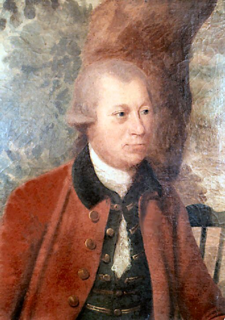
James II Templer
James Templer was the eldest son and heir of James I Templer, of Stover House, Teigngrace, Devon, a self-made magnate who had made his fortune building dockyards.
Templer was a Master in the Crown Office at London. He inherited the Stover estate in 1782, and began construction of a new church at Teigngrace, built in the local granite from quarries at Hay Tor. This was completed in 1787, and his brother Rev. John Templer of Lindridge House was the first rector of the church. The mining of ball clay in the area had begun to rapidly expand, and from 1790 Templer built the Stover Canal at his own expense to transport clay to cellars on the banks of the River Teign, for onward transportation by barge down the river estuary to the port of Teignmouth on the coast.
In 1776 he married Mary Buller, 3rd daughter of James Buller of Downes, Crediton, Member of Parliament for East Looe in Cornwall and for the County of Cornwall. By his wife he had progeny including:
George Templer, son and heir, who inherited the Stover estate.
Charlotte Frances Templer, who married twice:
Firstly in 1811 to Capt. Richard Dalling Dunn, Royal Navy
Secondly in 1819 to Capt. Charles Richard Acland , Royal Navy, 3rd son of Sir Thomas Dyke Acland, 9th Baronet, of Killerton House in Devon. He died from blackwater fever off Simondstown, South Africa.The marriage was without progeny
He died aged 65 on 21 June 1813, and is commemorated by a Coade stone monument in Teigngrace church.


RAP (Regency Assembly Press) in need of Beta-Readers
Regency Assembly
Press
is looking for
Beta Readers
One novel is ready for Beta Reading
We have a continuation of Pride and Prejudice with Ms Caroline Bingley and her fortune at stake:
Do we think that Mr Hurst married his Bingley Bride without incentive? It is highly probable that Caroline Bingley, even though she has a sharp, acerbic tongue, still is in possession of a fortune and an astute fortune hunter who deciphers this may soon be on the road to, if not a happy marriage, one with financial security.
Please respond or send an email if you are interested


Jane Austen Fans Rejoice, Jane is BACKKKK… Jane Austen and Ghosts
Special Sale Price!
Jane Austen and Ghosts.
Not only do I write Regency and Romance, but this can take a humorous turn. Some years back, I am sure readers of this blog will be aware that some writers began to take great liberty with Jane Austen and her works. Pride and Prejudice being liberally rewritten with the inclusion of zombies.
Then other books appeared with sea monsters, and werewolves and vampires. President Lincoln has even made it to the big screen where he is intent on sending foul creatures to hell. It occurred to me, even before I read any of this literature, that Jane would probably not appreciate what had been done to her classic piece.
That the tales and her life have become visual spectacles that we enjoy she might not like either, but is perhaps resigned to. That zombies, ghosts and vampires are now used to follow her own plot lines would I think, have her turning over in her grave. Jane Austen and Ghosts is my take on that.
It is now available in a variety of formats. For a limited time it has been reduced to $2.99 for your eReaders and $8.99 for paperback you can get this Jane Austen adventure.
Barnes and Noble for your Nook
and in Paperback
In the world of moviemaking, nothing is as golden as rebooting a classic tale that has made fortunes every time before when it has been adapted for the silver screen.
Certainly any work by Jane Austen made into a movie will not only be bankable, but also considered a work of art. That is of course until the current wave of adaptations that unite her classic stories with all the elements of the afterlife is attempted to be created.
That these have found success in the marketplace amongst booklovers may not be quite understood by those who make movies. But that they are a success is understood and a reason to make them into movies.
All that being said, perhaps it would also be fair to say that the very proper Jane, were she present to have anything to say about it, would not be pleased. Of course she has been away from this Earth for nearly 200 hundred years.
But does that mean were she upset enough, she wouldn’t come back?
Feedback
If you have any commentary, thoughts, ideas about the book (especially if you buy it, read it and like it
You Ought to Trust Your Mother (YOTTYM) now released
Now available the next Regency Romance tale by D.W. Wilkin:
Beauty has been said to be in the eye of the Beholder, or is it the Beholden.
The tale of Baron Fallion Lancelot Stafford, a gentleman of perhaps too much leisure who has served in the wars of some few years before. He now has decided that all this leisure is perhaps a waste and he should be doing something. He was just very unsure what that was.
We also find Lady Beatrice Cavendish, the daughter of the Earl of Hoare who is famed for her beauty, yet cannot find any man who has more to speak to her beyond that one subject. And yet far too many think they should offer for her with only the ardent praise to her looks to recommend them. Perhaps there exists one suitor who could speak on a subject beyond that?
In the rush of the Season of 1821, where their most intimate friends have all come to the conclusion that they should marry, can Beatrice put aside her willful ways and hear sound thoughts that her mama has said on that particular subject? Beatrice was sure that her mother would be content if she accepted the Baron Tweedglen, or any of a dozen other men of good breeding, position, or wealth. Whether they had ought to speak on her attractiveness, and no other words would leave their mouths.
Certainly a marriage with such foundations was doomed to crumble once age advanced and liver spots or wrinkles appeared. Yet amongst the Ton, such marriages were often deemed successes. Would they be so for Beatrice, though. That was something she was destined to apply her own thoughts to.
For Baron Tweedglen, the haunting memory of the war caused him to avoid any reference to his time spent prosecuting that undertaking. Such deamons as consumed his psyche, were magnified as his desire was for a world that art flourished and certainly his experience had been the exact opposite of such an inclination. The Baron was desperately in need of something that could save him from his ownself. Was there a remedy in marriage as the entire Ton seemed to believe?
Now available on Amazon for $15.99…
also available for your Kindle and Kindle Reading Apps for $3.99


May 14, 2016
Regency Personalities Series-Lord Dudley Stuart
Regency Personalities Series
In my attempts to provide us with the details of the Regency, today I continue with one of the many period notables.
Lord Dudley Stuart
11 January 1803, London – 17 November 1854
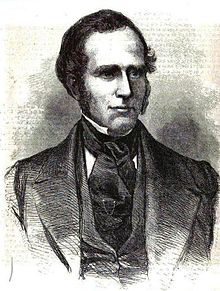
Lord Dudley Stuart
Lord Dudley Stuart was a British politician. He was the youngest son of John Stuart, 1st Marquess of Bute, and his second wife, Frances Coutts, daughter of the banker Thomas Coutts.
In 1820, he was admitted to Christ Church, Oxford.
On 20 July 1824, he married Princess Christine Bonaparte (1798–1847), daughter of Lucien Bonaparte by his first wife, Christine Boyer, and sister of the Princess Gabrielli. They had one son, Paul Amadeus Francis Coutts Stuart, who died unmarried in 1889.
He was a member of the Whittington Club and the vice-president (and later the president) of the Literary Association of the Friends of Poland.
A Whig and subsequently Liberal, he was a passionate advocate of Polish independence, and sympathetic in general to the cause of the Eastern European peoples against Russia. He received Lajos Kossuth in England after his exile from Hungary.
A critic of the Metropolitan Police, he suggested a reduction of the strength of the force in 1853.


Space Opera Books Presents A Trolling We Will Go (Book #1)
A Trolling We Will Go
Not only do I write Regency and Romance, but I also have delved into Fantasy.
The Trolling series, (the first three are in print) is the story of a man, Humphrey. We meet him as he has left youth and become a man with a man’s responsibilities. We follow him in a series of stories that encompass the stages of life.
We see him when he starts his family, when he has older sons and the father son dynamic is tested. We see him when his children begin to marry and have children, and at the end of his life when those he has loved, and those who were his friends proceed him over the threshold into death.
All this while he serves a kingdom troubled by monsters. Troubles that he and his friends will learn to deal with and rectify.
It is now available in a variety of formats. For $.99 you can get this fantasy adventure.
Barnes and Noble for your Nook
The Valley Kingdom of Torahn had been at peace for fifty years since the Council of Twenty-One saw fit to dispense with their royal family.
The only Kingdom without a King on the west side of the continent. But late last year, something caused the Goblins in the Old Forest, Karasbahn to stir and act courageous.
Something that men can not remember seeing Goblins ever doing. What has gotten the Goblins in such a state?
Whatever it is, it can not be good news for Torahn. Or for Humphrey, a woodcutter for a small town, far from Karasbahn.
But part of the Kingdom’s militia, with no family or other exemptions. He is perfect to be sent to the Old Forest and find out what scares the Goblins that they have become fearless.
Feedback
If you have any commentary, thoughts, ideas about the book (especially if you buy it, read it and like it
You Ought to Trust Your Mother (YOTTYM) now released
Now available the next Regency Romance tale by D.W. Wilkin:
Beauty has been said to be in the eye of the Beholder, or is it the Beholden.
The tale of Baron Fallion Lancelot Stafford, a gentleman of perhaps too much leisure who has served in the wars of some few years before. He now has decided that all this leisure is perhaps a waste and he should be doing something. He was just very unsure what that was.
We also find Lady Beatrice Cavendish, the daughter of the Earl of Hoare who is famed for her beauty, yet cannot find any man who has more to speak to her beyond that one subject. And yet far too many think they should offer for her with only the ardent praise to her looks to recommend them. Perhaps there exists one suitor who could speak on a subject beyond that?
In the rush of the Season of 1821, where their most intimate friends have all come to the conclusion that they should marry, can Beatrice put aside her willful ways and hear sound thoughts that her mama has said on that particular subject? Beatrice was sure that her mother would be content if she accepted the Baron Tweedglen, or any of a dozen other men of good breeding, position, or wealth. Whether they had ought to speak on her attractiveness, and no other words would leave their mouths.
Certainly a marriage with such foundations was doomed to crumble once age advanced and liver spots or wrinkles appeared. Yet amongst the Ton, such marriages were often deemed successes. Would they be so for Beatrice, though. That was something she was destined to apply her own thoughts to.
For Baron Tweedglen, the haunting memory of the war caused him to avoid any reference to his time spent prosecuting that undertaking. Such deamons as consumed his psyche, were magnified as his desire was for a world that art flourished and certainly his experience had been the exact opposite of such an inclination. The Baron was desperately in need of something that could save him from his ownself. Was there a remedy in marriage as the entire Ton seemed to believe?
Now available on Amazon for $15.99…
also available for your Kindle and Kindle Reading Apps for $3.99


May 13, 2016
Regency Personalities Series-Royal Academy of Arts
Regency Personalities Series
In my attempts to provide us with the details of the Regency, today I continue with one of the many period notables.
Royal Academy of Arts
1768- to Present
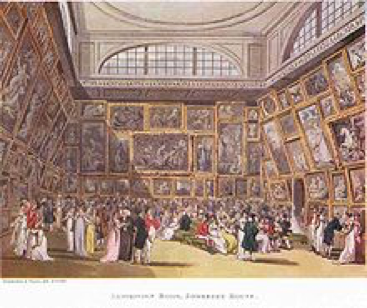
Royal Academy of Arts
Royal Academy of Arts is an art institution based in Burlington House on Piccadilly in London. It has a unique position as an independent, privately funded institution led by eminent artists and architects; its purpose is to promote the creation, enjoyment and appreciation of the visual arts through exhibitions, education and debate.
The Royal Academy of Arts was founded through a personal act of King George III on 10 December 1768 with a mission to promote the arts of design in Britain through education and exhibition. The motive in founding the Academy was twofold: to raise the professional status of the artist by establishing a sound system of training and expert judgement in the arts, and to arrange the exhibition of contemporary works of art attaining an appropriate standard of excellence. Supporters wanted to foster a national school of art and to encourage appreciation and interest in the public based on recognised canons of good taste.
Fashionable taste in 18th-century Britain was based on continental and traditional art forms, providing contemporary British artists little opportunity to sell their works. From 1746 the Foundling Hospital, through the efforts of William Hogarth, provided an early venue for contemporary artists in Britain. The success of this venture led to the formation of the Society of Artists of Great Britain and the Free Society of Artists. Both these groups were primarily exhibiting societies; their initial success was marred by internal factions among the artists. The combined vision of education and exhibition to establish a national school of art set the Royal Academy apart from the other exhibiting societies. It provided the foundation upon which the Royal Academy came to dominate the art scene of the 18th and 19th centuries, supplanting the earlier art societies.
Sir William Chambers, a prominent architect, used his connections with George III to gain royal patronage and financial support of the Academy, and it was founded in 1768. The painter Joshua Reynolds was made its first president. Francis Milner Newton was elected the first secretary, a post he held for two decades until his resignation in 1788.
The instrument of foundation, signed by George III on 10 December 1768, named 34 founder members and allowed for a total membership of 40. The founder members were Reynolds, John Baker, George Barret, Francesco Bartolozzi, Giovanni Battista Cipriani, Augustino Carlini, Charles Catton, Mason Chamberlin, William Chambers, Francis Cotes, George Dance, Nathaniel Dance, Thomas Gainsborough, John Gwynn, Francis Hayman, Nathaniel Hone the Elder, Angelica Kauffman, Jeremiah Meyer, George Michael Moser, Francis Milner Newton, Mary Moser, Edward Penny, John Inigo Richards, Thomas Sandby, Paul Sandby, Dominic Serres, Peter Toms, William Tyler, Samuel Wale, Benjamin West, Richard Wilson, Joseph Wilton, Richard Yeo, Francesco Zuccarelli. William Hoare and Johann Zoffany were added to this list later by the King and are known as nominated members. Among the founder members were two women, a father and daughter, and two sets of brothers.
The Royal Academy was initially housed in cramped quarters in Pall Mall, although in 1771 it was given temporary accommodation for its library and schools in Old Somerset House, then a royal palace. In 1780 it was installed in purpose-built apartments in the first completed wing of New Somerset House, located in the Strand and designed by Chambers, the Academy’s first treasurer. The Academy moved in 1837 to Trafalgar Square, where it occupied the east wing of the recently completed National Gallery (designed by another Academician, William Wilkins). These premises soon proved too small to house both institutions. In 1868, 100 years after the Academy’s foundation, it moved to Burlington House, Piccadilly, where it remains. Burlington House is owned by the British Government, and used rent-free by the Royal Academy.
The first Royal Academy exhibition of contemporary art, open to all artists, opened on 25 April 1769 and ran until 27 May 1769. 136 works of art were shown and this exhibition, now known as the Royal Academy Summer Exhibition, has been staged annually without interruption to the present day. In 1870 the Academy expanded its exhibition programme to include a temporary annual loan exhibition of Old Masters, following the cessation of a similar annual exhibition at the British Institution. The range and frequency of these loan exhibitions have grown enormously since that time, making the Royal Academy a leading art exhibition institution of international importance.
Britain’s first public lectures on art were staged by the Royal Academy, as another way to fulfil its mission. Led by Reynolds, the first president, a program included lectures by Dr. William Hunter, John Flaxman, James Barry, Sir John Soane, and J. M. W. Turner. The last three were all graduates of the RA School, which for a long time was the only established art school in the country.
The Royal Academy does not receive financial support from the state or the Crown. Its income is from exhibitions, trust and endowment funds, receipts from its trading activities, and from the subscriptions of its Friends and corporate members. It also gains funds by sponsorship from commercial and industrial companies, in which the Academy was one of the pioneers.
The Royal Academy Schools was the first institution to provide professional training for artists in Britain. The Schools’ programme of formal training was modelled on that of the French Académie de peinture et de sculpture, founded by Louis XIV in 1648. It was shaped by the precepts laid down by Sir Joshua Reynolds. In his fifteen Discourses delivered to pupils in the Schools between 1769 and 1790, Reynolds stressed the importance of copying the Old Masters, and of drawing from casts after the Antique and from the life model. He argued that such a training would form artists capable of creating works of high moral and artistic worth. Professorial chairs were founded in Chemistry, Anatomy, Ancient History and Ancient Literature, the latter two being held initially by Samuel Johnson and Oliver Goldsmith.
In 1769, the first year of operation, the Schools enrolled 77 students. By 1830 over 1,500 students had enrolled in the Schools, giving an average intake of 25 students each year. They included men such as John Flaxman, J. M. W. Turner, John Soane, Thomas Rowlandson, William Blake, Thomas Lawrence, John Constable, George Hayter, David Wilkie, William Etty and Edwin Landseer. The term of studentship was at first six years. This was increased to seven years in 1792 and to ten in 1800.
The Royal Academy has an important collection of books, archives and works of art accessible for research and display. A large part of these collections have been digitised and can be investigated through the Collection website.
The first president of the Royal Academy, Sir Joshua Reynolds, gave his noted self-portrait, beginning the Royal Academy collection. This was followed by gifts from other founding members, such as Gainsborough and Benjamin West. Subsequently each elected Member was required to donate an artwork (known as a “Diploma Work”) typical of his or her artistic output, and this practice continues today. Additional donations and purchases have resulted in a collection of approximately a thousand paintings and a thousand sculptures, which show the development of a British School of art.
Membership of the Royal Academy is composed of practising artists, each elected by ballot of the General Assembly of the Royal Academy, and known individually as Royal Academicians (RA, or more traditionally as R.A.). The Royal Academy is governed by these Royal Academicians. The 1768 Instrument of Foundation allowed total membership of the Royal Academy to be 40 artists. The category of Associate Member of the Royal Academy (ARA, traditionally as A.R.A.) was introduced in 1769 to provide a means of preselecting suitable candidates to fill future vacancies among Academicians.[citation needed] Originally engravers were completely excluded from the academy, but at the beginning of 1769 the category of Associate-Engraver was created. Their number was limited to six, and unlike other associates, they could not be promoted to full academicians,[15] In 1853 membership of the Academy was increased to 42.
President
Served
Joshua Reynolds
1768–1792
Benjamin West
1792–1805
James Wyatt
1805–1806
Benjamin West
1806–1820
Thomas Lawrence
1820–1830
Martin Archer Shee
1830–1850
Keeper
Served
George Michael Moser, RA
10 Dec 1768 – 24 Jan 1783
Agostino Carlini, RA
3 Mar 1783 – 24 Sep 1790
Joseph Wilton, RA
24 Sep 1790 – 25 Nov 1803
Henry Fuseli, RA
24 Dec 1804 – 16 Apr 1825
Henry Thomson, RA
9 Jun 1825 – 10 Dec 1827
William Hilton, RA
10 Dec 1827 – 30 Dec 1839
Treasurer
Served
William Chambers
10 Dec 1768 – 8 Mar 1796
John Yenn
2 Apr 1796 – 8 Jun 1820
Robert Smirke
8 Jun 1820 – 18 Jul 1850
Secretary
Served
Francis Milner Newton, RA
10 Dec 1768 – 10 Dec 1788
John Inigo Richards, RA
10 Dec 1788 – 2 Mar 1810
Henry Howard, RA
11 Feb 1811 – 20 Jan 1847
Name
Elected
Notes
John Baker
1768
Foundation member
George Barret
1768
Foundation member
Francesco Bartolozzi
1768
Foundation member
Agostino Carlini
1768
Foundation member
Charles Catton
1768
Foundation member
Mason Chamberlin
1768
Foundation member
William Chambers
1768
Foundation member
Giovanni Battista Cipriani
1768
Foundation member
Francis Cotes
1768
Foundation member
George Dance the Younger
1768
Foundation member; Professor of Architecture 1798–1805
Nathaniel Dance-Holland
1768
Foundation member
Thomas Gainsborough
1768
Foundation member
John Gwynn
1768
Foundation member
Francis Hayman
1768
Foundation member; first Academy librarian
Nathaniel Hone
1768
Foundation member
Angelica Kauffman
1768
Foundation member
Jeremiah Meyer
1768
Foundation member
George Michael Moser
1768
Foundation member; first Keeper
Mary Moser
1768
Foundation member
Francis Milner Newton
1768
Foundation member; first Secretary
Edward Penny
1768
Foundation member
Joshua Reynolds
1768
Foundation member; President 1768–1792
John Inigo Richards
1768
Foundation member; Secretary 1788–1810
Paul Sandby
1768
Foundation member
Thomas Sandby
1768
Foundation member; first Professor of Architecture
Dominic Serres
1768
Foundation member; Librarian 1792–1793
Peter Toms
1768
Foundation member
William Tyler
1768
Foundation member
Samuel Wale
1768
Foundation member
Benjamin West
1768
Foundation member; President 1792–1805, 1806–1820
Richard Wilson
1768
Foundation member
Joseph Wilton
1768
Foundation member; third Keeper
Richard Yeo
1768
Foundation member
Francesco Zuccarelli
1768
Foundation member
William Hoare
1769
Nominated member
Johann Zoffany
1769
Nominated member
Richard Cosway
1771
Joseph Nollekens
1772
Philip James de Loutherbourg
1781
George Stubbs
1781
Joseph Wright
1784
Thomas Banks
1785
James Wyatt
1785
President 1805
James Northcote
1787
John Opie
1788
John Russell
1788
Henry Fuseli
1790
Professor of Painting 1799–1803, 1810–1824; Keeper 1803–1810?
Ozias Humphrey
1791
John Yenn
1791
Robert Smirke
1793
Thomas Lawrence
1794
President 1820–1830
Richard Westall
1794
Thomas Stothard
1794
John Hoppner
1795
William Beechey
1798
Associate RA: 1793
Henry Tresham
1799
Professor of Painting 1807–1809
John Flaxman
1800
Professor of Sculpture 1810–1826
Martin Archer Shee
1800
President 1830–1850
John Soane
1802
Professor of Architecture 1806–1837
J. M. W. Turner
1802
Thomas Phillips
1808
Professor of Painting 1824–1832
James Ward
1811
David Wilkie
1811
Richard Westmacott
1811
Professor of Sculpture 1827–1856
Robert Smirke
1811
Philip Reinagle
1812
William Theed
1813
George Dawe
1814
John Jackson
1817
Edward Hodges Baily
1821
Jeffry Wyatville
1824
William Wilkins
1826
Professor of Architecture 1837–1839
Charles Lock Eastlake
1827
President 1850–1865
William Etty
1828
John Constable
1829
Edwin Henry Landseer
1831
Clarkson Stanfield
1835
Charles Robert Cockerell
1836
Professor of Architecture 1839–1856
John Peter Gandy
1838
Frederick Richard Lee
1838



